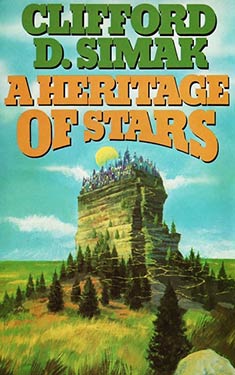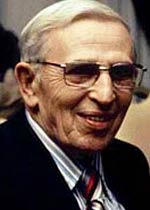Clifford Simak Doubts His Religion
 Clifford D. Simak became the third SFWA Grand Master in 1977, but few contemporary SF fans know his work today. A Heritage of Stars is one of his later books, one so obscure that Wikipedia doesn’t even have an entry for this 1977 novel. Simak was born in 1904, and died in 1988, so A Heritage of Stars was written in his mid-seventies, towards the end of his career. I think that’s significant because the book feels like a summation of Simak’s thoughts on science fiction. I know the older I get, the more I want to make sense of a lifetime of reading science fiction.
Clifford D. Simak became the third SFWA Grand Master in 1977, but few contemporary SF fans know his work today. A Heritage of Stars is one of his later books, one so obscure that Wikipedia doesn’t even have an entry for this 1977 novel. Simak was born in 1904, and died in 1988, so A Heritage of Stars was written in his mid-seventies, towards the end of his career. I think that’s significant because the book feels like a summation of Simak’s thoughts on science fiction. I know the older I get, the more I want to make sense of a lifetime of reading science fiction.
We’ve been reading A Heritage of Stars in my book club this month, and the consensus was it’s ho-hum. However, this is my second reading, and the story has improved — significantly. Simak cranked out sixteen novels in the last two decades of his life. Most of them have no entries on Wikipedia. Simak is famous for City (1952) and Way Station (1963), with his first story published in a 1931 issue of Wonder Stories. He wrote science fiction for six decades!
When you consider Simak’s unique perspective, A Heritage of Stars, takes on new meaning. It’s still just an average SF novel cranked out by a prolific writer, but I think it has something insightful to say about the genre we all love. I met Simak at a convention around this time, and I was shocked by how this Grand Master was ignored by young fans. Star Wars had just come out, and new fans were streaming into fandom. At the con they flocked to guests from media related science fiction, not old writers. Simak even looked from the past.
Writers of Simak’s era wrote science fiction as a gospel preaching promises of wondrous futures. Today, science fiction has become something different. Stories are often like fantasy, good storytelling and entertainment, with a bit of pop culture wisdom. Modern science fiction appears to inhabit the dreams of science fiction past. Something happened to science fiction when we stopped going to the Moon in 1972, and then spent over forty years just circling the Earth. NASA in the 1960s, with Projects Mercury, Gemini, and Apollo felt like it had grown out of 1950s Astounding Stories. Reading science fiction in the 1960s convinced fans we’d get to Mars in the 1970s, and the rest of the solar system by the 1990s. The 21st century would be beyond amazing. Here it’s 2016, and we’re still just jawboning about going to Mars. What happened?
Science fiction came of age with Simak in the 1950s, and peers like Heinlein, Asimov, Norton, Williamson, and Clarke. 1950s science fiction asked a lot of questions and generated its own theology. Science fiction’s true believers knew humans would go to the stars, build intelligent robots and evolve psychic powers. That’s the heaven 1950s science fiction promised, the collapse of civilization was its hell and brimstone.
A Heritage of Stars is Simak’s reevaluation of that theology. This is not a book review, so I’m going to give spoilers. If you don’t want to know them, read no further.
One thing that came through loud and clear in this novel is the legacy of L. Frank Baum and his Oz books. I read the fourteen canonical Oz books when I was a child in the early 1960s. Writers like Simak and Heinlein read them in the 1910s. Oz books became a tradition, published in time for Christmas. The original series ran from 1900-1920. Shelves of dissertations could be written on the impact of Oz books on science fiction writers. But there’s something else to note. Around the time the country was banning DC Comics, librarians decided not to carry Oz books because they claimed those books inspired unrealistic expectations in children. Couldn’t we say that about science fiction too?



















 Full Details
Full Details


